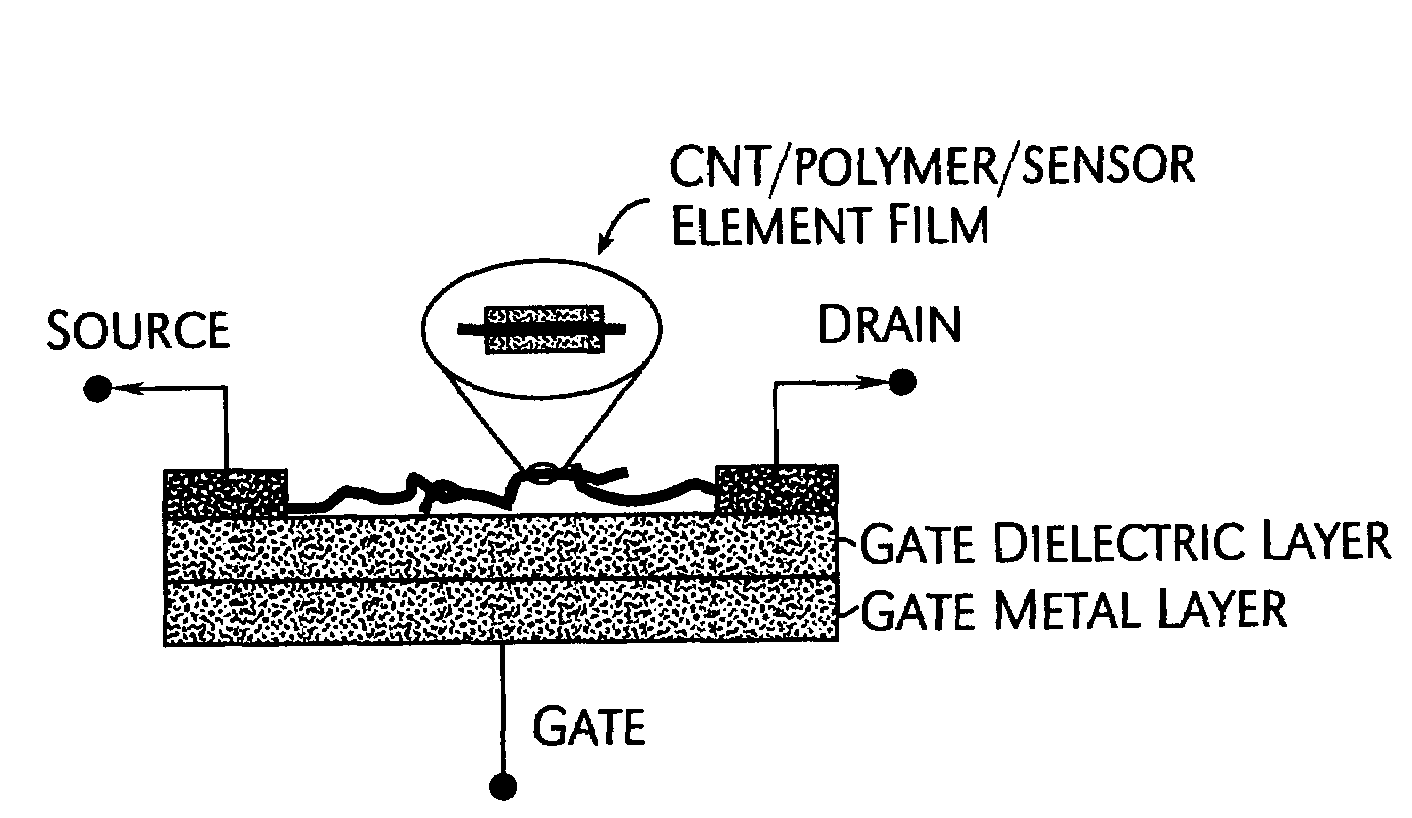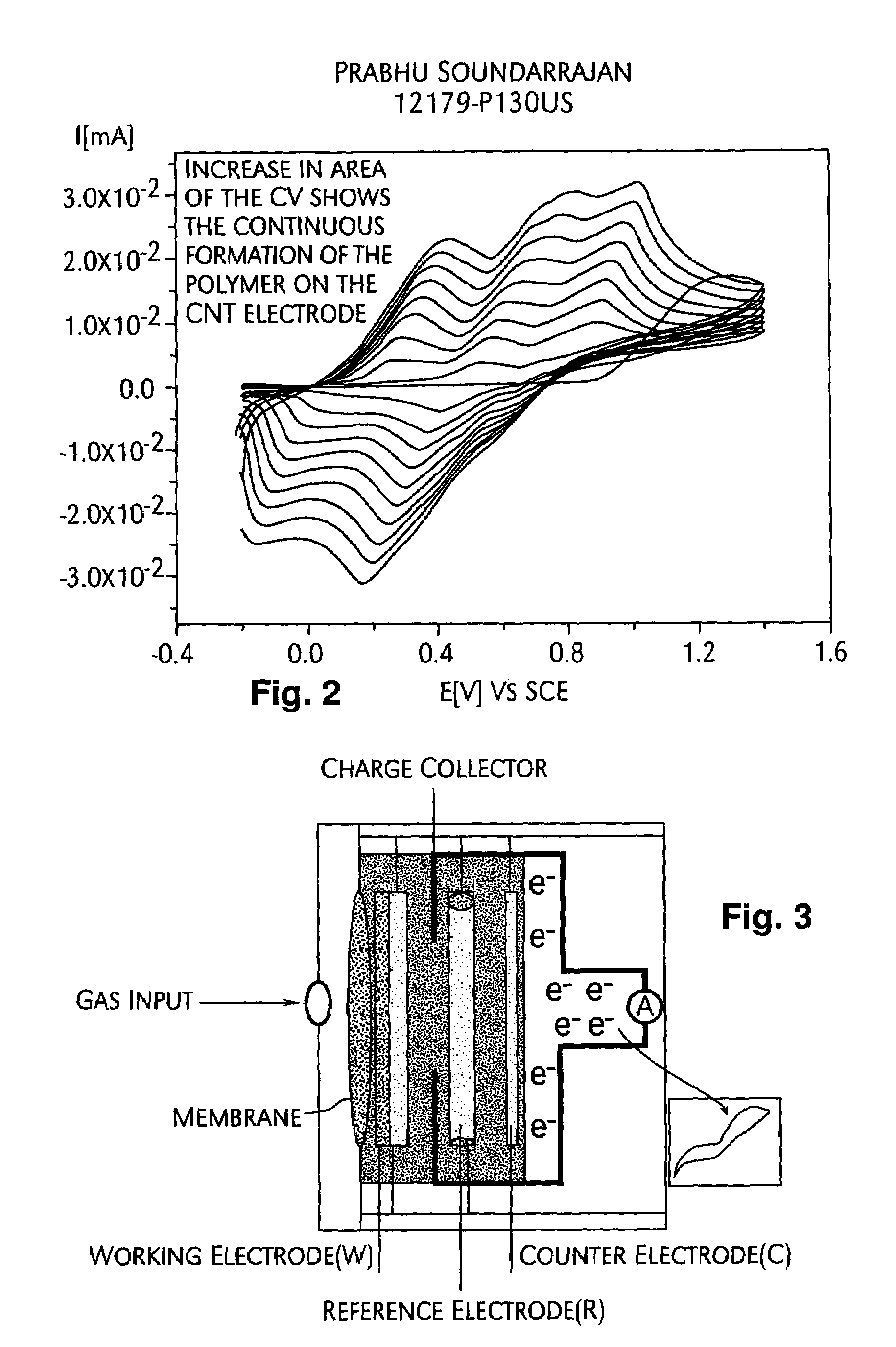Nanobiosensor and carbon nanotube thin film transistors
a carbon nanotube and nanotube technology, applied in nanoinformatics, liquid/fluent solid measurement, biomass after-treatment, etc., can solve the problems of limited performance of liquid electrolyte sensors, limited sensitivity and selectivity of conventional sensing electrodes used to immobilize biological enzymes, and limited sensor performan
- Summary
- Abstract
- Description
- Claims
- Application Information
AI Technical Summary
Benefits of technology
Problems solved by technology
Method used
Image
Examples
example 1
Electrochemical Instrumentation and Materials
[0101]Instrumentation: Experiments using electro-polymerization were carried out using a three electrode Gamry (v. 4.02) electrochemical system coupled to a Gamry Potentiostat (PCI4 / 300). The three electrodes included a working, counter and Ag / AgCl reference. The measurements and analysis were performed and recorded using the Gamry Software (v. 1.02).
[0102]Materials: Single-walled carbon nanotubes (SWNTs) and multi-walled carbon nanotubes (MWNTs) may be purchased from any source. In the CNT-TFT, the SWNTs used have diameters that range from 1 to 3 nm and lengths that range from less than one micron to greater than 10 μm. SWNTs have been used “as-produced” (AP) or purified with similar results. This disclosure does not specify how the carbon nanotubes were made, although methods that deliver higher concentrations of semiconducting nanotubes may be used, either as produced or as a post-fabrication process procedure.
[0103]In the nanobiosenso...
example 2
Preparation of Carbon Nanotube Electrodes
[0104]Carbon nanotube paste electrodes (0.5 cm2) were prepared by mixing 50% by weight of carbon nanotubes with 43% by weight of organic vehicle and 7% by weight of glass frit in a mortar and pestle for 30 minutes followed by grinding in a three roll mill for 20 minutes to disperse the clusters in the mixture. The composite was then screen printed through a mask of known area onto a silicon substrate, vacuum evaporated with 20 angstroms chromium and 500 angstroms gold. The substrate was then baked at 100° C. for 10 minutes in an oven and cooled at room temperature as illustrated in FIG. 1. Different weight percentages of carbon nanotubes can also be employed for the electrode preparation. The prepared carbon nanotube paste electrodes may be fired (hard baked) to remove the organic vehicle and activated using a tape.
[0105]Carbon nanotube spray electrodes (0.5 cm2) were prepared by dissolving a known quantity of carbon nanotubes (e.g., 0.1 g) i...
example 3
Preparation of Carbon Nanotube-conducting Polymer Composite Electrodes
[0107]Electrochemical polymerization onto the carbon nanotube electrodes (applicable to all the electrodes discussed above) was carried out by the oxidation of aniline (0.1 M) in a solution containing 1 M H2SO4 in a pH 7.0 buffer solution. A potential window of −1.04 V to 0.96 V was employed for the electropolymerization with a scan rate of 50 mV / s for 10 cycles. Electropolymerization to form the polypyrrole was carried out by the oxidation of pyrrole (0.1 M) in a solution containing 0.1 M NaClO4 in a pH 7.0 buffer solution under the same electrochemical conditions. The electrodes were washed with water and dried in air.
PUM
| Property | Measurement | Unit |
|---|---|---|
| anodic potentials | aaaaa | aaaaa |
| area | aaaaa | aaaaa |
| lengths | aaaaa | aaaaa |
Abstract
Description
Claims
Application Information
 Login to View More
Login to View More - R&D
- Intellectual Property
- Life Sciences
- Materials
- Tech Scout
- Unparalleled Data Quality
- Higher Quality Content
- 60% Fewer Hallucinations
Browse by: Latest US Patents, China's latest patents, Technical Efficacy Thesaurus, Application Domain, Technology Topic, Popular Technical Reports.
© 2025 PatSnap. All rights reserved.Legal|Privacy policy|Modern Slavery Act Transparency Statement|Sitemap|About US| Contact US: help@patsnap.com



